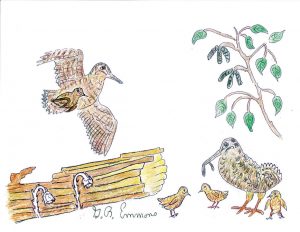The American woodcock species has a fancy Latin classification entitled Philohela Minor, but it is actually a down-to-Earth ground-nesting buff-colored bird with black markings as illustrated. Slightly larger than a quail, it looks quite different with a long bill and a flexible upper mandible to probe deep into the ground to capture and extract earthworms, its staple diet. Sometimes they rock their bodies as they forage, shifting back and forth to prompt worms to move underground to make sounds helpful to detection.
The woodcock migrates to the region in spring from as far south as Louisiana, progressing northward in movement with the receding frost line that liberates access to food in the soil, which includes snails, spiders, flies, beetles, and ants. Habitat for nesting can be a shrubby forest, farm fields near abandoned orchards, or adjacent to wetlands.
To begin nesting, a spectacular aerial courtship dance by the male begins as the sun goes down. In the twilight, he takes off from the female and spirals upward in a wide circling pattern several hundred feet into the air, all the while emitting a rasping ‘peent’ (sound specific to the woodcock) to his mate below. At the very apex of his towering circular figure eight, he suddenly folds his wings and dives straight down to reunite with the female standing by to welcome him with the similar-sounding love song.
The nest itself is usually a shallow depression in leaf and twig litter just big enough for four eggs that imitate the hen’s coloring, so camouflaged to be invisible, except for the large dark oval eye watching your every move. If you get too close, she will move away, feinting a characteristic Mother Nature impersonation of a broken wing trick to get your attention away from the nest. Once she feels her nest location has been discovered, she will move each of the eggs, one by one, tightly clasped between her legs and fly low over the ground to a more secret location. I have also seen a hen similarly moving each of her four chicks across a well-traveled road for their safety.
The name ‘woodcock’ comes from across the pond in jolly old England because of their routine habit of flying from a daytime resting covert to an evening feeding covert. Seeing this out the window of a thatched cottage, it was to be called “cockshut time” to close the shutters and latch them against the spirits of the cold damp air. The name of the English cocker spaniel also comes from an ability to find and flush this game bird for hunters. In this country, recent year-end bird surveys suggest populations slowly declining, but not from hunting. Rather, the decline is due to habitat destruction by building development and accumulated pesticides from aerial spraying.
As the woodcock survives for the pleasure of our bird watching today, if you stumble upon one in your trail walks, it may suddenly startle you with a frantic wispy whistling of wing beats – but all for naught, landing a short distance away only to come back after you have gone. For the future, conservation of the Earth-bound food and habitat is critical, as important to our environmental awareness as it is vital for species survival.
By George B. Emmons
